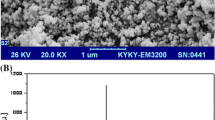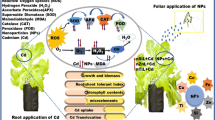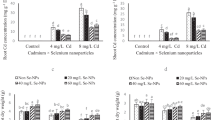Abstract
Contamination of agricultural land by chromium (Cr) can inhibit physiological and biochemical processes in plants, leading to reduced crop productivity and food/feed safety. Owing to their fine size, large surface area, and high adsorption affinity for metals, nanomaterials have shown a potential for phytoremediation of heavy metal-contaminated soils. Nanomaterials enhance fitness of plants under metal stress through their modifying effects on plant physiology and biochemistry. The aim of this study was to assess the performance of sunflower (Helianthus annuus) plants grown in soil spiked with hexavalent chromium (Cr IV; 0, 75 and 150 ppm) and the potential role of nano-zerovalent iron (Fe0 nanoparticles; 0, 1 and 2%) to ameliorate Cr toxicity. Results revealed that the Cr uptake decreased by increasing the concentration of Fe0 nanoparticles, causing a significant enhancement in plant morphological and physiological attributes. Treatment with Fe0 nanoparticles reduced bioaccumulation factor (BAF) (in both root and shoot tissues) and translocation factor (TF); however, the magnitude of BAF and TF decreased significantly by increasing the level of Cr(VI). Chromium stress increased the activities of antioxidant enzymes, which further increased by Fe0 nanoparticle application, resulting in improved growth traits. A significant positive correlation was found between growth, BAF and TF of seedlings treated with Fe0 nanoparticles (both 1 and 2%) upon Cr exposure (75 and 150 ppm). The results demonstrated the potential of Fe0 nanoparticles to improve performance of sunflower plants under Cr toxicity through reducing their Cr uptake, which was accompanied by enhanced activity of detoxification enzymes (SOD, CAT, POX, and APX) in cells.


Similar content being viewed by others
References
Aebi H (1984) Catalase in vitro. Methods Enzymol 105:121–126
Ali S, Bai P, Zeng F, Cai S, Shamsi IH, Qiu B, Wu F, Zhang G (2011) The ecotoxicological and interactive effects of chromium and aluminum on growth, oxidative damage and antioxidant enzymes on two barley genotypes differing in Al tolerance. Environ Exp Bot 70(2):185–191
Alia Mohanty P, Matysik J (2001) Effect of proline on the production of singlet oxygen. Amino Acids 21:195–200
Amin H, Arain BA, Amin F, Surhio MA (2013) Phytotoxicity of chromium on germination, growth and biochemical attributes of Hibiscus esculentus L. Am J Plant Sci 4:2431–2439
Apel K, Hirt H (2004) Reactive oxygen species: metabolism, oxidative stress, and signal transduction. Annu Rev Plant Biol 55:373–399
Asgari Lajayer B, Ghorbanpour M, Nikabadi S (2017a) Heavy metals in contaminated environment: destiny of secondary metabolite biosynthesis, oxidative status and phytoextraction in medicinal plants. Ecotoxicol Environ Saf 145:377–390
Asgari Lajayer H, Savaghebi G, Hadian J, Hatami M, Pezhmanmehr M (2017b) Comparison of copper and zinc effects on growth, micro and macronutrients status and essential oil constituents in pennyroyal (Mentha pulegium L.). Braz J Bot 40:379–388
Asgari LB, Khadem Moghadam N, Maghsoodi MR, Ghorbanpour M, Kariman Kh (2019) Phytoextraction of heavy metals from contaminated soil, water and atmosphere using ornamental plants: mechanisms and efficiency improvement strategies. Environ Sci Pollut Res 26:8468
Baiazidi-Aghdam MT, Mohammadi H, Ghorbanpour M (2016) Effects of nanoparticulate anatase titanium dioxide on physiological and biochemical performance of Linum usitatissimum (Linaceae) under well watered and drought stress conditions. Braz J Bot 39:139–146
Barnhart N (1997) Chromium and its soils in the proximity of the old tannery waste lagoon. Int Agrophys 15:121–124
Barton LL, Johnson AG, Wagener BM (2000) Inhibition of ferric chelate reductase in alfalfa roots by cobalt, nickel, chromium and copper. J Plant Nutr 23:1833–1845
Bhowmick S, Chakraborty S, Mondal P, Van Renterghem W, Van den Berghe S, Roman-Ross G, Chatterjee D, Iglesias M (2014) Montmorillonite-supported nanoscale zero-valent iron removal of arsenic from aqueous solution: kinetics and mechanism. Chem Eng J 243:14–23
Bishnoi NR, Chugh LK, Sawhney SK (1993) Effect of chromium on photosynthesis, respiration and nitrogen fixation in pea (Pisum sativum L.) seedlings. J Plant Physiol 142:25–30
Borowiak K, Drzewiecka K, Magdziak Z, Gasecka M, Mleczek M (2012) Effect of Ca/Mg ions ratio on copper accumulation, photosynthetic activity and growth of Cu2+-treated Salix viminalis L. ‘Cannabina’. Photosynthetica 50:353. https://doi.org/10.1007/s11099-012-0040-8
Bradford MM (1976) A rapid and sensitive method for the quantitation of microgram quantities of protein utilizing the principle of protein-dye binding. Anal Biochem 72(1–2):248–254
Brooks RR (1998) Plants that hyperaccumulate heavy metals. Their role in phytoremediation, microbiology, archaeology, mineral exploration and phytomining. CAB International, Wallingford, p 380
Chance B, Maehly AC (1955) Assay of catalases and peroxidases. Methods Enzymol 2:764–775
Clemens S (2001) Molecular mechanisms of plant metal tolerance and homeostasis. Planta 212:475–486
Cohen MD, Kargacin B, Klein CB, Costa M (1993) Mechanism of chromium carcinogenicity and toxicity. Crit Rev Toxicol 23:255–281
Dhindsa RS, Dhindsa PP, Thorpe TA (1980) Leaf senescence correlated with increased levels of membrane permeability and lipid-peroxidation and decreased levels of superoxide dismutase and catalase. J Exp Bot 32:93–101
Forte J, Mutiti S (2017) Phytoremediation potential of Helianthus annuus and Hydrangea paniculata in copper and lead-contaminated soil. Water Air Soil Pollut 228:1–11
Gadd GM (2007) Geomycology: biogeochemical transformations of rocks, minerals, metals and radionuclides by fungi, bioweathering and bioremediation. Mycol Res 111:3–49
Ghorbanpour M, Hadian J (2015) Multi-walled carbon nanotubes stimulate callus induction, secondary metabolites biosynthesis and antioxidant capacity in medicinal plant Satureja khuzestanica grown in vitro. Carbon 94:749–759
Ghorbanpour M, Hatami H (2015) Changes in growth, antioxidant defense system and major essential oils constituents of Pelargonium graveolens plant exposed to nano-scale silver and thidiazuron. Ind J Plant Physiol. 20(2):116–123
Giannopolitis CN, Ries SK (1977) Superoxide dismutases occurrence in higher plants. Plant Physiol 59:309–314
Hatami M, Hosseini SM, Ghorbanpour M, Kariman K (2019) Physiological and antioxidative responses to GO/PANI nanocomposite in intact and demucilaged seeds and young seedlings of Salvia mirzayanii. Chemosphere 233:920–935
Houben D, Sonnet P (2010) Leaching and phytoavailability of zinc and cadmium in a contaminated soil treated with zero-valent iron. In: Proceedings of the 19th world congress of soil science, soil solutions for a changing world, pp 1–6
Jabeen R, Ahmad A, Iqbal M (2009) Phytoremediation of heavy metals: physiological and molecular mechanisms. Bot Rev 75:339–364
Janas KM, Zieli A, Ska-Tomaszewska J, Rybaczek D, Maszewski J, Posmyk MM, Amarowicz R, Kosińska A (2010) The impact of copper ions on growth, lipid peroxidation, and phenolic compound accumulation and localization in lentil (Lens culinaris Medic.) seedlings. J Plant Physiol 167:270–276
Juwarkar AA, Singh SK, Mudhoo A (2010) A comprehensive overview of elements in bioremediation. Rev Environ Sci Biotechnol 9:215–288
Kumar NP, Dushenkov V, Motto H, Raskin I (1995) Phytoextraction: the use of plants to remove heavy metals from soils. Environ Sci Technol 29:1232–1238
Ladislas S, El-Mufleh A, Gerente C, Chazarenc F, Andres Y, Bechet B (2012) Potential of aquatic macrophytes as bioindicators of heavy metal pollution in urban stormwater runoff. Water Air Soil Pollut 223:877–888
Liang D, Wang B, Song S, Wang J, Wang L, Ren X, Zhao X (2019) Analysis of genetic effects on a complete diallel cross test of Pinus koraiensis. Euphytica 215(5):92
Liu JH, Inoue H, Moriguchi T (2008) Salt stress-mediated changes in free polyamine titers and expression of genes responsible for polyamine biosynthesis of apple in vitro shoots. Environ Exp Bot 62:28–35
Macnair MR, Tilstone GH, Smith SE (2000) The genetics of metal tolerance and accumulation in higher plants. In: Terry N, Banuelos G (eds) Phytoremediation of contaminated soil and water. CRC Press, Boca Raton, pp 235–250
Maiti S, Ghosh N, Mandal C, Das K, Dey N, Adak MK (2012) Responses of the maize plant to chromium stress with reference to antioxidation activity. Braz J Plant Physiol 24(3):203–212
Malik JA, Kumar S, Thakur P, Sharma S, Kaur N, Kaur R, Pathania D, Bhandhari K, Kaushal N, Singh K, Srivastava A (2011) Promotion of growth in mungbean (Phaseolus aureus Roxb.) by selenium is associated with stimulation of carbohydrate metabolism. Biol Trace Elem Res 143(1):530–539
Malik JA, Goel S, Kaur N, Sharma S, Singh I, Nayyar H (2012) Selenium antagonises the toxic effects of arsenic on mungbean (Phaseolus aureus Roxb.) plants by restricting its uptake and enhancing the antioxidative and detoxification mechanisms. Environ Exp Bot 77:242–248
Marschner H (1995) Mineral nutrition of higher plants, 2nd edn. Academic, London
Mehta SK, Gaur JP (1999) Heavy metal induced proline accumulation and its role in ameliorating metal toxicity in Chlorella vulgaris. New Physiol 143:253–259
Mohammadi H, Hatami M, Feghezadeh K, Ghorbanpour M (2018) Mitigating effect of nano-zerovalent iron, iron sulfate and EDTA against oxidative stress induced by chromium in Helianthus annuus L. Acta Physiol Plant 40:69
Nakano Y, Asada K (1981) Hydrogen peroxide is scavenged by ascorbate-specific peroxidase in spinach chloroplasts. Plant Cell Physiol 22(5):867
Nasiri J, Gholami A, Panahpour E (2013) Removal of cadmium from soil resources using stabilized zero-valent iron nanoparticles. J Civ Eng Urban 3:338–341
Noctor G, Foyer CH (1998) Ascorbate and glutathione: keeping active oxygen under control. Annu Rev Plant Physiol Plant Mol Biol 49:249–279
Obrouchova NV, Bystrova EI, Ivanov VB, Anupova O, Seregin I (1998) Root growth responses to lead in young maize seedlings. Plant Soil 200:55–61
Padmavathiamma PK, Li LY (2007) Phytoremediation technology: hyperaccumulation metals in plants. Water Air Soil Pollut 184:105–126
Panda SK, Choudhury S (2005) Chromium stress in plants. Braz J Plant Physiol 17:95–192
Piechalak A, Tomaszewska B, Barałkiewicz D, Malecka A (2002) Accumulation and detoxification of lead in legumes. Phytochemistry 60:153–162
Poguberović SS, Krčmar DM, Maletić SP, Kónya Z, Pilipović DD, Kerkez DV, Rončević SD (2016) Removal of As (III) and Cr(VI) from aqueous solutions using “green” zero-valent iron nanoparticles produced by oak, mulberry and cherry leaf extracts. Ecol Eng 90:42–49
Prasad MNV, Strzaka K (2002) Physiology and biochemistry of metal toxicity and tolerance in plants. Plant Sci 161:881–889
Qu X, Alvarez PJ, Li Q (2013) Applications of nanotechnology in water and wastewater treatment. Water Res 47:3931–3946
Radojevic M, Bashkin VN (1999) Practical environmental analysis. Royal Society of Chemistry, Cambridge
Sandmann G, Böger P (1980) Copper-mediated lipid peroxidation processes in photosynthetic membranes. Plant Physiol 66:797–800
Shanker KA, Cervantes C, Loza-Taversa H, Avudainayagam S (2005) Chromium toxicity in plants. Environ Int 31:739–753
Shi J, Abid AD, Kennedy IM, Hristova KR, Silk WK (2011) To duckweeds (Landoltia punctata), nanoparticulate copper oxide is more inhibitory than the soluble copper in the bulk solution. Environ Pollut 159:1277–1282
Singh J, Lee BK (2016) Influence of nano-TiO2 particles on the bioaccumulation of Cd in soybean plants (Glycine max): a possible mechanism for the removal of Cd from the contaminated soil. J Environ Manag 170:88–96
Singh HP, Mahajan P, Kaur S, Batish DR, Kohli RK (2013) Chromium toxicity and tolerance in plants. Environ Chem Lett 11(3):229–254
Song J, Zhang H, Duan C, Cui X (2018) Exogenous application of succinic acid enhances tolerance of Larix olgensis seedling to lead stress. J For Res 29(6):1497–1505
Sun RL, Zhou QX, Jin CX (2006) Cadmium accumulation in relation to organic acids in leaves of Solanum nigrum L. as a newly found cadmium hyperaccumulator. Plant Soil 285:125–134
Sundaramoorthy P, Alagappan C, Kaliyaperumal SG, Pachikkaran U, Logalashmanan B (2010) Chromium stress in paddy: (i) nutrient status of paddy under chromium stress; (ii) phytoremediation of chromium by aquatic and terrestrial weeds. CR Biol 333:597–607
Tafazoli M, Hojjati SM, Biparva P, Kooch Y, Lamersdorf N (2017) Reduction of soil heavy metal bioavailability by nanoparticles and cellulosic wastes improved the biomass of tree seedlings. J Plant Nutr Soil Sci 180:683–693
Tian H, Ghorbanpour M, Kariman K (2018) Manganese oxide nanoparticle-induced changes in growth, redox reactions and elicitation of antioxidant metabolites in deadly nightshade (Atropa belladonna L.). Ind Crops Prod 126:403–414
Tripathi DK, Singh VP, Prasad SM, Chauhan DK, Dubey NK, Rai AK (2015) Silicon-mediated alleviation of Cr(VI) toxicity in wheat seedlings as evidenced by chlorophyll florescence, laser induced breakdown spectroscopy and anatomical changes. Ecotoxicol Environ Saf 113:133–144
Tucker M (1974) A modified heating block foe plant tissue digestion 1. Commun Soil Sci Plant Anal 5:539–546
Vamerali T, Bandiera M, Mosca G (2010) Field crops for phytoremediation of metal-contaminated land. A review. Environ Chem Lett 8:1–17
Van Assche F, Clijsters H (1990) Effect of metal on enzyme activity in plants. Plant Cell Environ 13:195–206
Verma S, Dubey R (2003) Lead toxicity induces lipid peroxidation and alters the activities of antioxidant enzymes in growing rice plants. Plant Sci 164:645–655
Vilardi G, Verdone N, Di Palma L (2017) The influence of nitrate on the reduction of hexavalent chromium by zero-valent iron nanoparticles in polluted wastewater. Desalin Water Treat 86:252–258
Wang C, Luo H, Zhang Z, Wu Y, Zhang J, Chen S (2014) Removal of As(III) and As(V) from aqueous solutions using nanoscale zero valent iron-reduced graphite oxide modified composites. J Hazard Mater 268:124–131
Watanabe T, Murata Y, Nakamura T, Sakai Y, Osaki M (2009) Effect of zero-valent iron application on cadmium uptake in rice plants grown in cadmium-contaminated soils. J Plant Nutr 32:1164–1172
Zayed A, Lytle CM, Jin-Hong Q, Terry N, Qian JH (1998) Chromium accumulation, translocation and chemical speciation in vegetable crops. Planta 206:293–299
Zenk M (1996) Heavy metal deteoxification. Curr Opin Plant Biol 3:211–216
Zhuang P, Yang Q, Wang H, Shu W (2007) Phytoextraction of heavy metals by eight plant species in the field. Water Air Soil Pollut 184:235–242
Zu YQ, Li Y, Chen JJ, Chen HY, Qin L, Schvartz C (2005) Hyperaccumulation of Pb, Zn and Cd in herbaceous plants grown on lead–zinc mining area in Yunnan, China. Environ Int 31:755–762
Acknowledgements
This study was supported by Deputy of Research and Technology of Azarbaijan Shahid Madani University (95/D/897), Tabriz, Iran.
Author information
Authors and Affiliations
Corresponding author
Ethics declarations
Conflict of interest
The authors declare that he/she has no conflict of interest.
Rights and permissions
About this article
Cite this article
Mohammadi, H., Amani-Ghadim, A.R., Matin, A.A. et al. Fe0 nanoparticles improve physiological and antioxidative attributes of sunflower (Helianthus annuus) plants grown in soil spiked with hexavalent chromium. 3 Biotech 10, 19 (2020). https://doi.org/10.1007/s13205-019-2002-3
Received:
Accepted:
Published:
DOI: https://doi.org/10.1007/s13205-019-2002-3




